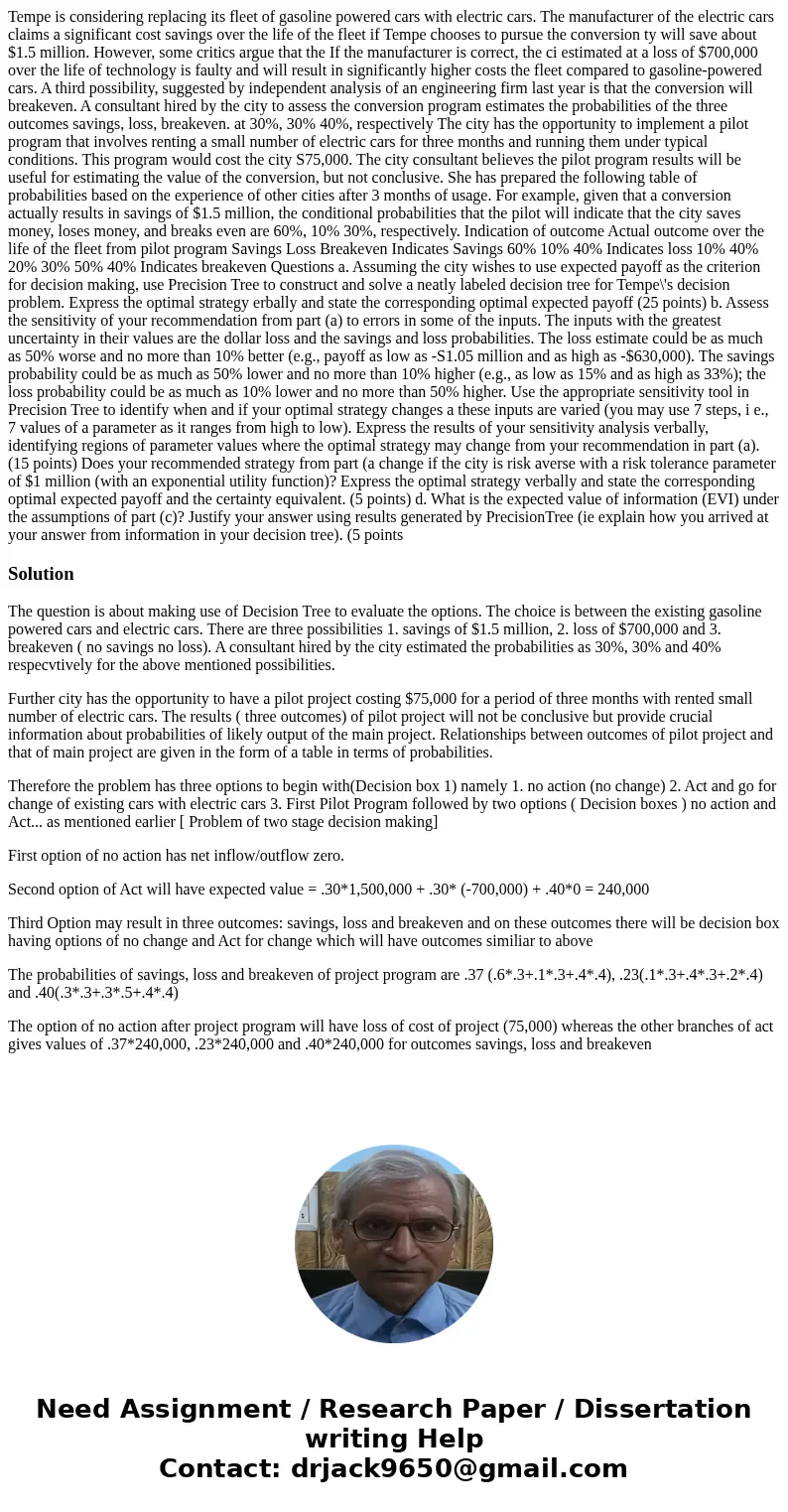Tempe is considering replacing its fleet of gasoline powered cars with electric cars. The manufacturer of the electric cars claims a significant cost savings over the life of the fleet if Tempe chooses to pursue the conversion ty will save about $1.5 million. However, some critics argue that the If the manufacturer is correct, the ci estimated at a loss of $700,000 over the life of technology is faulty and will result in significantly higher costs the fleet compared to gasoline-powered cars. A third possibility, suggested by independent analysis of an engineering firm last year is that the conversion will breakeven. A consultant hired by the city to assess the conversion program estimates the probabilities of the three outcomes savings, loss, breakeven. at 30%, 30% 40%, respectively The city has the opportunity to implement a pilot program that involves renting a small number of electric cars for three months and running them under typical conditions. This program would cost the city S75,000. The city consultant believes the pilot program results will be useful for estimating the value of the conversion, but not conclusive. She has prepared the following table of probabilities based on the experience of other cities after 3 months of usage. For example, given that a conversion actually results in savings of $1.5 million, the conditional probabilities that the pilot will indicate that the city saves money, loses money, and breaks even are 60%, 10% 30%, respectively. Indication of outcome Actual outcome over the life of the fleet from pilot program Savings Loss Breakeven Indicates Savings 60% 10% 40% Indicates loss 10% 40% 20% 30% 50% 40% Indicates breakeven Questions a. Assuming the city wishes to use expected payoff as the criterion for decision making, use Precision Tree to construct and solve a neatly labeled decision tree for Tempe\'s decision problem. Express the optimal strategy erbally and state the corresponding optimal expected payoff (25 points) b. Assess the sensitivity of your recommendation from part (a) to errors in some of the inputs. The inputs with the greatest uncertainty in their values are the dollar loss and the savings and loss probabilities. The loss estimate could be as much as 50% worse and no more than 10% better (e.g., payoff as low as -S1.05 million and as high as -$630,000). The savings probability could be as much as 50% lower and no more than 10% higher (e.g., as low as 15% and as high as 33%); the loss probability could be as much as 10% lower and no more than 50% higher. Use the appropriate sensitivity tool in Precision Tree to identify when and if your optimal strategy changes a these inputs are varied (you may use 7 steps, i e., 7 values of a parameter as it ranges from high to low). Express the results of your sensitivity analysis verbally, identifying regions of parameter values where the optimal strategy may change from your recommendation in part (a). (15 points) Does your recommended strategy from part (a change if the city is risk averse with a risk tolerance parameter of $1 million (with an exponential utility function)? Express the optimal strategy verbally and state the corresponding optimal expected payoff and the certainty equivalent. (5 points) d. What is the expected value of information (EVI) under the assumptions of part (c)? Justify your answer using results generated by PrecisionTree (ie explain how you arrived at your answer from information in your decision tree). (5 points
The question is about making use of Decision Tree to evaluate the options. The choice is between the existing gasoline powered cars and electric cars. There are three possibilities 1. savings of $1.5 million, 2. loss of $700,000 and 3. breakeven ( no savings no loss). A consultant hired by the city estimated the probabilities as 30%, 30% and 40% respecvtively for the above mentioned possibilities.
Further city has the opportunity to have a pilot project costing $75,000 for a period of three months with rented small number of electric cars. The results ( three outcomes) of pilot project will not be conclusive but provide crucial information about probabilities of likely output of the main project. Relationships between outcomes of pilot project and that of main project are given in the form of a table in terms of probabilities.
Therefore the problem has three options to begin with(Decision box 1) namely 1. no action (no change) 2. Act and go for change of existing cars with electric cars 3. First Pilot Program followed by two options ( Decision boxes ) no action and Act... as mentioned earlier [ Problem of two stage decision making]
First option of no action has net inflow/outflow zero.
Second option of Act will have expected value = .30*1,500,000 + .30* (-700,000) + .40*0 = 240,000
Third Option may result in three outcomes: savings, loss and breakeven and on these outcomes there will be decision box having options of no change and Act for change which will have outcomes similiar to above
The probabilities of savings, loss and breakeven of project program are .37 (.6*.3+.1*.3+.4*.4), .23(.1*.3+.4*.3+.2*.4) and .40(.3*.3+.3*.5+.4*.4)
The option of no action after project program will have loss of cost of project (75,000) whereas the other branches of act gives values of .37*240,000, .23*240,000 and .40*240,000 for outcomes savings, loss and breakeven

 Homework Sourse
Homework Sourse